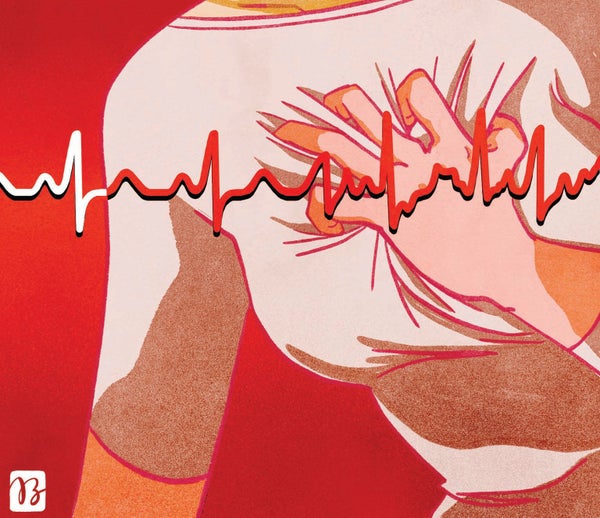Two years ago I was walking in a park with an older relative when she suddenly stopped and put her hands out for support. Her heartbeat had gone haywire, causing chest pains and making her feel lightheaded and short of breath. The incident ended after a few minutes, but it was alarming to both of us. Yet it was also familiar for her—she had felt these sensations a few times before. Over the next year these episodes happened more and more often, and eventually she felt unwell most of the time. It was atrial fibrillation, or A-fib, which turns a normal, regular heartbeat into a rapid, irregular and dangerous stutter.
Fortunately, my relative's A-fib has been successfully treated with medication and cardioversion, a procedure that uses a jolt of electricity to shock the heart back into a normal rhythm. But since my introduction to A-fib that day in the park, I've met it repeatedly. Another relative recently needed cardioversion twice. And I learned that a friend had a stroke triggered by A-fib when he was in his 50s. In addition to strokes, A-fib can bring on heart attacks, cardiac failure, blood clots and even dementia.
I'm not imagining the sudden ubiquity of this condition. Its prevalence has quadrupled over the past 50 years, according to recent studies. These high numbers are partly attributable to increased surveillance—the more you look for A-fib, the more you find it. But the jump also reflects the fact that people live longer than they did decades ago, and age is a risk factor. There has been a parallel rise in conditions such as obesity, diabetes and high blood pressure, which also heighten risk, even in younger people. Smoking and sleep apnea are additional risk factors. Epidemiologists now put the lifetime risk of A-fib at about one in three for white people older than 40. For Black people, it is one in five. The reason for that lower prevalence is unclear. It might be partly a result of underdiagnosis.
Yet a third of people who have A-fib don't know it. An episode can come and go quickly (paroxysmal A-fib), so people might feel tired or short of breath for a moment but recover and not go to a doctor about it. A 2023 study estimated that over a two-year period almost one quarter of cases will go undiagnosed.
A-fib occurs when electrical signals in the upper chambers of the heart—the atria—misfire. The resulting irregular heartbeat causes blood to pool instead of being pumped out to the lower chambers. In addition to its deadly consequences, A-fib can make people physically uncomfortable and limit their activities. “We've begun to appreciate the toll A-fib takes on the quality of life,” says cardiologist and electrophysiologist Mintu Turakhia of Stanford University.
Atrial fibrillation is also a primary example of the effects of health inequities, says cardiologist Jared Magnani of the University of Pittsburgh: “It's a disease that requires monitoring and detection. And then it requires access to medical care, with a partner in making decisions about things like [medication], and finally more advanced therapies and treatment.” A 2022 study published in Circulation showed that compared with residents in well-to-do neighborhoods in Ontario, Canada, residents of the province's most deprived areas were less likely to visit a cardiologist or to receive treatment for A-fib and had poorer outcomes.
There has also been a sex gap in diagnosis and treatment, says Louise Segan, a cardiologist and electrophysiologist at the Alfred Hospital and a researcher at the Baker Heart and Diabetes Institute, both in Melbourne, Australia. Segan has treated many women who had previously been told that their A-fib symptoms were caused by anxiety. Some weren't referred for treatment at the same rate as men, she says. Earlier studies suggested women experience more complications after cardiac interventions, but recent research is helping to debunk this idea. An extensive 2023 subanalysis of a large study published in JAMA Cardiology showed no significant differences in outcomes by sex for people treated with a new technology called pulsed field ablation.
The benefits of detecting A-fib early are considerable. When clinicians can restore normal rhythm, Turakhia says, it alters the trajectory of disease and outcomes for years to come. Paroxysmal A-fib is easier to treat than the more serious “persistent” version of the disease. For all types, lifestyle changes such as improving nutrition, stopping smoking and cutting back on alcohol are more effective early as well. There are also medications that can slow heart rate and control the rhythm. In November 2023 leading medical groups issued new guidelines for preventing and treating A-fib. They call for a stronger focus on heart-healthy habits and early, more aggressive efforts to control heart rhythms.
The good news is that A-fib is getting more attention, in part thanks to publicity campaigns—one features basketball great and writer Kareem Abdul-Jabbar talking about his diagnosis with the condition. A-fib is also well suited to the growing popularity of wearable technology, which could catch more undiagnosed cases. For instance, the 2019 Apple Heart Study showed that the Apple Watch could successfully detect irregular heart rhythms. Confirmation of A-fib still requires further testing, but that, too, can be done at home with wearable electrocardiography patches, which record days' worth of data and get returned to physicians for analysis. This type of ongoing monitoring is particularly useful for a condition that can come and go before a patient gets to a doctor's office.
More than 400,000 people downloaded the Apple Study app and agreed to participate in the research, which suggests A-fib is on people's minds. And the earlier it's on their minds, the less likely it is to be in their hearts.
This is an opinion and analysis article, and the views expressed by the author or authors are not necessarily those of Scientific American.
